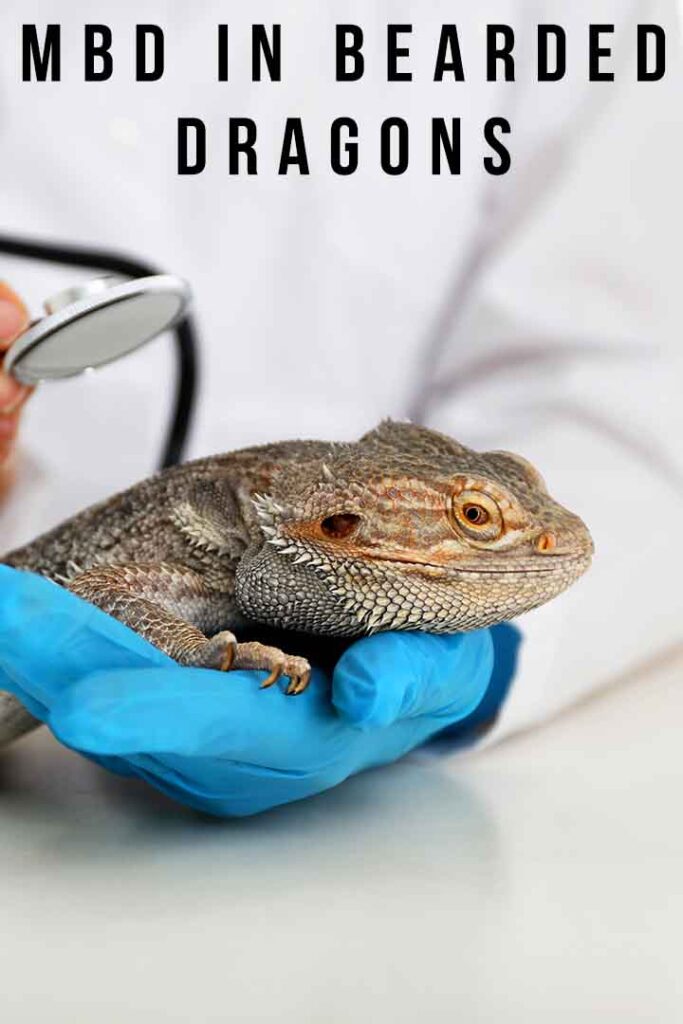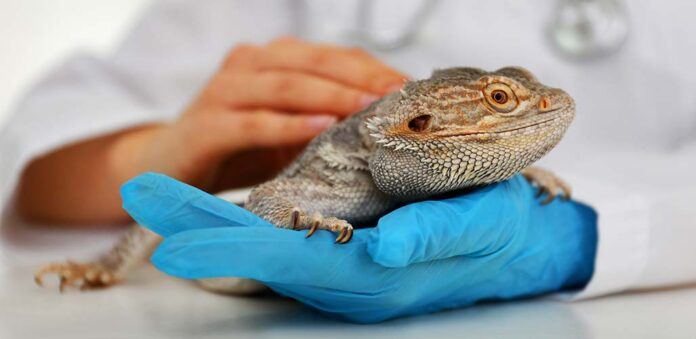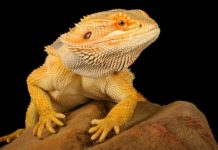Welcome to our detailed explainer about what the term ‘MBD bearded dragon’ means. We’ll cover what MBD is, how it affects beardies, how to prevent it and whether it can be treated.
- What is MBD in bearded dragons?
- Causes of bearded dragon MBD
- Early signs of MBD in bearded dragons
- Can MBD kill bearded dragons?
- Can a bearded dragon recover from MBD?
- How to treat MBD in bearded dragons
- How to prevent metabolic bone disease in bearded dragons
MBD stands for metabolic bone disease. It is one of the most common health problems of pet bearded dragons. MBD is usually triggered by a shortcoming in their environment or diet. If caught early enough, it can be treated, but preventing it in the first place is better!
The first thing you need to know about MBD is that it’s not one single condition. It’s an umbrella term for several similar ailments. We’ll reveal more right away.
What is MBD in bearded dragons?
MBD stands for metabolic bone disease. Metabolic bone diseases are actually a group of disorders including:
- Nutritional secondary hyperparathyroidism (NSHPT). NSHPT is the most common metabolic bone disease. It is a collection of symptoms caused by lack of calcium.
- Renal secondary hyperparathyroidism (RSHPT). Calcium deficiency in the bloodstream brought on by kidney failure.
- Osteomalacia and rickets. Failure of bones to calcify normally in adult and juvenile beardies, respectively.
- Fibrous osteodystrophy. Reabsorption of bone and replacement with soft fibrous tissue.
- Osteoporosis. Loss of bone density.
- Hypocalcemia. Low calcium levels in the blood.
Bearded dragons are most likely to be diagnosed with MBD before their 2nd birthday. But calcium deficiency is so widespread, that some practice advice for veterinarians recommends assuming all beardies are affected, unless proven otherwise.
Causes of bearded dragon MBD
Metabolic bone diseases are all brought by calcium deficiency. There are few ways in which beardies can end up without enough calcium in their body:
- Insufficient calcium in their diet. Calcium is an element. Which means it can’t be made inside the body from other things. It must enter the body as part of a beardie’s diet.
- Too much calcium in their diet. Whilst vital for their health, too much dietary calcium can actually interfere with mineral uptake from the intestines to the bloodstream, and cause calcium deficiency.
- Insufficient vitamin D3 in their diet. Beardies use vitamin D3 to make a hormone called calcitriol, which enhances calcium absorption from the intestines into the bloodstream.
- Too much phosphorus in their diet. Phosphorus blocks calcium absorption from the intestines to the bloodstream.
- Too many oxalates in their diet. Oxalates also inhibits calcium absorption from the intestines.
- Inadequate lighting. Specifically, beardies need UVB lighting in their habitat, which they use to make vitamin D in their skin. And vitamin D, as we know, is critical for absorbing dietary calcium.
So, most beardies with MBD either don’t have enough calcium in their diet in the first place, or something else is stopping them from making use of the available calcium. A common culprit is filling up on too many crickets and mealworms, which are low in calcium, and high in phosphorus.
Early signs of metabolic bone disease in bearded dragons
Calcium has lots of important roles in a healthy bearded dragon. So the early symptoms of calcium deficiency are diverse, and often easily mistaken for other problems. The first signs of MBD are:
- stunted growth
- a rounded skull, especially when viewed from the side
- lack of appetite
- lack of energy and general weakness
- constipation
Some of these symptoms obviously relate to bone development. But calcium is also vital for muscle function, including the muscles responsible for pushing food along the gut. So some symptoms relate to movement and digestion too. Blood tests reveal hypocalcemia (low calcium levels in the blood stream) from an early stage of MBD – even before clinical symptoms develop. Which means this disease potentially builds up for a while before it becomes noticeable.

Advanced symptoms of metabolic bone disease in bearded dragons
MBD progresses relatively slowly. This is partly because it takes a while for the consequences of calcium deficiency to accumulate. And partly because animals instinctively conceal any evidence that they are unwell, so as not to make themselves an obvious target for predators. Advanced signs of a bearded dragon with MBD include:
- An upper jaw which extends beyond their lower jaw. This happens when the bone in the lower jaw gets pulled backwards, because it is weaker than the muscles which operate it.
- Hard, swollen limbs. Often described as looking ‘Popeye-like’.
- Softening of the jaw and facial bones, also known as ‘rubber jaw’.
- Bowed legs. Or forelegs which splay out horizontally below the elbow, instead of tucking under vertically.
- Fractures. Including broken bones which can’t obviously be attributed to major trauma.
- Greenstick fractures. Bones which have folded or bent without snapping, because absence of calcium has made them so soft.
- Twitching, tremors and trembling limbs, due to loss of muscle control.
- Weakness, paralysis or difficulty moving.
- Being unable to stand, or properly support their own weight.
- Being unable to eat even when hungry.
- Impaction and diarrhea. Loss of muscle function in the gut wall increases the likelihood of blockages and impaction. Diarrhea is liquid material leaking past the blockage.
The more symptoms a beardie has, the more advanced the disease is likely to be, and the worse the prognosis for them. So it’s in their best interests to consult a vet as soon as you spot any of the early or advanced symptoms.
Can MBD kill bearded dragons?
Sadly yes, metabolic bone disease can be fatal if left untreated. The more it progresses, the more guarded veterinarians become about the odds of successfully treating it too. In severe cases, the stress of treatment needs to be balanced against the probability of it working. For some beardie owners, the cost of treatment is simply too prohibitive. And we know MBD causes pain, but our understanding of how to manage pain in reptiles is still underdeveloped. So sadly for a significant number of MBD bearded dragons, euthanasia is the kindest course of action. But thankfully not all. So let’s look at treatment for the animals which can be saved next.
Can a bearded dragon recover from MBD?
Yes, bearded dragons can recover if they are diagnosed and treated quickly. Just as the disease takes a while to develop, the symptoms take a while to reverse as well. So owners have to commit to an extended period of treatment. Let’s see what that treatment might look like.
How to treat MBD in bearded dragons
First of all, MBD should always treated under the supervision of a veterinarian. It is not wise to try and correct the symptoms without professional support. Since beardies conceal symptoms of pain and discomfort, a detailed medical assessment will be required to establish the full extent of the problem. This will involve a lot of questions, and possibly blood tests and x-rays. To help your beardie recover, your veterinarian might prescribe intravenous calcium, and/or drugs to improve calcium uptake in their body. They will also be keen to identify what gap in their care led to them developing a calcium deficiency in the first place. Correcting that mistake will be the only way to make their recovery permanent.
How to prevent metabolic bone disease in bearded dragons
Perhaps the most important thing about bearded dragon MBD is that it is entirely avoidable with the right care. These MBD-preventing tips can help keep your beardie safe!
Increase their calcium intake by gut loading prey insects and including salad leaves in their diet. But avoid spinach, cabbage and beet greens, which are high in oxalates. Dust live prey and salad leaves with a calcium supplement immediately before serving. Only add them to the tank when your beardie is warm and ready to eat.
Make sure the calcium supplement you use is designed for beardies. And that it definitely contains calcium! Calcium is a mineral not a vitamin, so supplements labelled ‘complete vitamin care for bearded dragons’ might not have any calcium in them. Supplements originally designed for other species might contain calcium, but also too much phosphorus.
Don’t forget it is possible to have too much of a good thing. If you’re new to owning a beardie, check with a more experienced owner or a veterinarian that you’re getting it right.
UVB bulbs lose efficiency over time. Check how long your bulb will last, and replace it promptly. Don’t put anything between your beardie and the bulb which could filter the light.
Make sure they have enough water. Bearded dragons are adapted for desert conditions, but they still need moisture to survive. In dry periods wild beardies use underground burrows and clumps of long grass to shelter in and retain moisture. Low level dehydration caused by overexposure to heat without access to water will affect how well they digest food and take up calcium.
MBD bearded dragon summary
Metabolic bone diseases are a group of painful conditions which all have a lack of calcium in common. They usually develop slowly, but the longer they progress, the longer they take to put right. Proper care is the best way to protect your dragon in the first place, but if you spot any symptoms at all, prompt veterinary treatment is the next best thing.
If you have experience of caring for a beardie with MBD, please tell us about it in the comments box down below, and whether your lizard made a full recovery.
More bearded dragon resources
- Can Bearded Dragons Eat Bananas?
- Can Bearded Dragons Eat Grapes?
- Bearded Dragon Stress Marks
- Bearded Dragon Names – Awesome Ideas For Naming Your Dragon
- Albino Bearded Dragon
- Do Bearded Dragons Have Teeth?
References
Hedley. Metabolic bone disease in reptiles: Part 1. UK Vet Companion Animal. 2013.
Hedley. Metabolic bone disease in reptiles: Part 2. UK Vet Companion Animal. 2013.
Klaphake. A Fresh Look at Metabolic Bone Diseases in Reptiles and Amphibians. Veterinary Clinics: Exotic Animal Practice. 2010.
Pajdak et al. Histopathological lesions associated with metabolic bone disease in the central bearded dragon. Journal of Comparative Pathology. 2016.
Schmidt-Ukaj et al. A survey of diseases in captive bearded dragons: a retrospective study of 529 patients. CAAS Agricultural Journals. 2017.
Wright. Two Common Disorders of Captive Bearded Dragons: Nutritional Secondary Hyperparathyroidism and Constipation. Journal of Exotic Pet Medicine. 2008.















